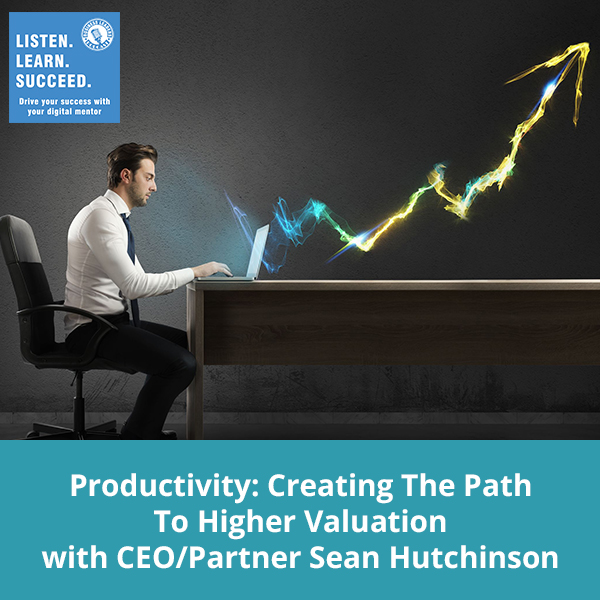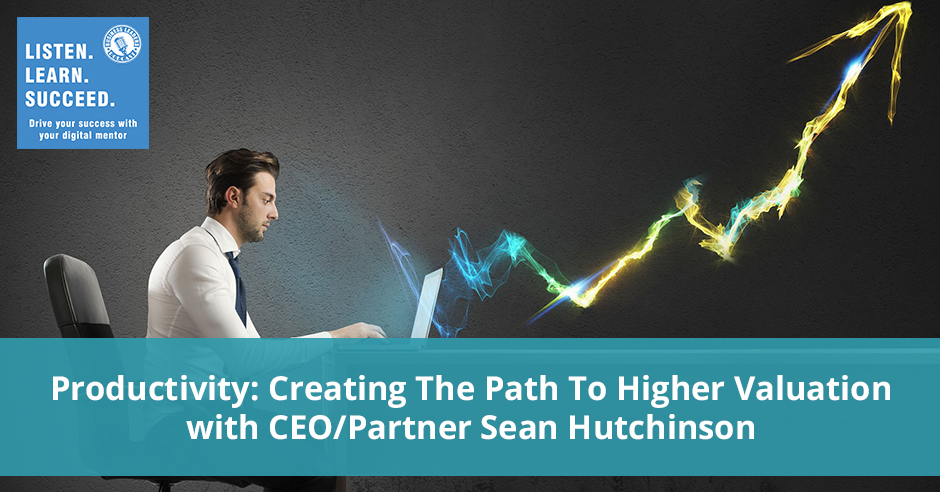Productivity: Creating The Path To Higher Valuation with CEO/Partner Sean Hutchinson


Everybody understands what productivity is. It’s basically doing more with less. The former chairman of Procter & Gamble once said productivity is everything in every business. Sean Hutchinson, CEO/Partner of SVA Value Accelerators, talks about the productivity accelerator which is the fourth out of seven value accelerators. Sean says the reason that it’s in the middle is that it provides an important inflection point built on what’s happened before and it’s a predictor of what happens in the future. Learn more about productivity as Sean talks about the tools for productivity, the value-added process mapping, quality control, risk reduction, and more.
—
Productivity: Creating The Path To Higher Valuation with CEO/Partner Sean Hutchinson
Creating The Path To Higher Valuation with CEO/Partner Sean Hutchinson
We’re doing a continuation deep dive from an original podcast. We did it with Sean Hutchinson of SVA Value Accelerators. What we’re going to be talking about is part of the Value Acceleration methodology. We’re going to be talking about the productivity portion of that. Sean, thanks again.
The former chairman of Procter & Gamble once said, “Productivity is everything in every business.” This particular piece of our Value Accelerator, the Productivity Accelerator, comes four out of seven. The reason that it’s in the middle is that it provides an important inflection point built on what’s happened before and it’s a predictor of what happens in the future. Value creation and value acceleration tend to not be linear. It’s more of a slow climb and then there’s an inflection point where it takes off. The exponential value curve is a scoop. One of the things that inflects that curve and gets it to move into a steep incline is increases in productivity. Everybody understands what productivity is but it’s doing more with less. There are a couple of different places in your numbers that you’re going to see it on your financial statements, but one place is in the gross margin. Not the net margin necessarily.
The gross margin is the indicator of financial productivity in the organization, of essential throughput of the assets. How quickly did they get through the organization? How quickly did they produce income cash? How quickly did they generate margin? Productivity is about not just efficiency, but it’s also about velocity. It’s also about the efficient use of capital within the organization. What are the tools that we use? One tool is called $50 to $5,000. It is a concept that came out of Rob Slee’s book, Midas Managers. It’s an amazing concept and it’s been effective with our clients. If I go into a management team for instance or even talking to an owner and I say, “How much of your day do you spend doing $50 an hour work?” If they don’t land immediately on a percentage, which tends to be in the 90% of the day or above then the answer is way too much. That’s an immediate acknowledgment that productivity in the organization even at the top is dampened. It’s restricted. The reason for that is that not just the CEO, but everybody else in the organization is working on the wrong stuff.
There may be delegation problems. There may be process problems. There may be culture and communication problems. At the end of the day, stuff’s getting stuck in the organization. What we want in order to create economic value is for the highest-level strategic thinkers in the organization to be doing $5,000 an hour work. That’s where the juice gets put into the deal. Being aware is one piece of it. How much $50 an hour work are you doing? What are the things that are $50 an hour work? How quickly and how efficiently and how effectively can you transfer them to another person in the organization? We do what we call a $50 to $5,000 audit. It’s pretty simple. It’s a spreadsheet. We ask usually the owner, the management team to spend the next month writing down all the $50 an hour stuff that they do. Keep a journal on it right on a spreadsheet. Second, how much time did they spend on each one of those activities? Third, how important is that activity? How much of an impact does it have in the organization? Begin to identify the person that you’re going to transfer it to and set a date.
On one possibly extreme case we did it, we had a group of thirteen vice presidents in the organization. It’s a fairly large company, $85 million or something like that. They managed a lot of divisions. They had a lot of different roles in the company. What we had noticed though is that the production coming out of those positions was not as high as you would expect it to be. Big strategic questions and issues were being left to the wayside and it seemed the management team was working on stuff that should be handled in another point in the organization. Importantly, as a result of that, the organization was not creating as much value as it could have been. We had thirteen VPs. They spent a month looking at it. We took that information and we annualized it through discussion with them, “Is this typical of a month or was it unusual? What on here might have been a one-time deal?” Once we normalized it out, thirteen times 2,080, let’s assume that they’re working 2,000 hours a year. We’ve got about 27,000 hours or something like that in the year. 22,000 hours were identified as $50 an hour work.
Productivity is everything in every business.
Think about the impact of that on the organization. First of all, it trickles all the way down at every point in the organization when something is getting stuck or something’s not being done at the right investment level in the organization. $50 to $5,000 is an incredibly powerful tool and I can tell you that of all the bumper stickers that may be present in the Value Acceleration, $50 to $5,000 is one that always sticks with our clients and they talk about it over and over again. “I’m doing $50 an hour work again or I left some $5,000 opportunities out there,” but it gets them thinking in a different way. It changes behaviors, it changes the culture and it changes productivity. The second piece of productivity is what we call value stream mapping. The process is an important part of productivity. If you look at Kaizen, for instance, the basis of lean manufacturing, Six Sigma and things like that. Kaizen was the thing that Toyota used to reinvent its manufacturing processes. It’s thought that out of every 100 process steps in an organization of any kind, 95 are probably unnecessary. Each step in a process in order to realize full productivity, which is impossible, we know that. Each step in a process has to meet three criteria in order to add value to the process compared to where it was in the last step.
The first criteria are that the step changes the form, fit or function of whatever it is. The second piece of it is it must be done right the first time. The third piece is, will the customer pay for it? A simple example of unnecessary steps that I’m sure everyone is both aware of and frustrated by is when an invoice comes into the organization. Somebody reviews it, puts it in and then it’s got to go to somebody else, be re-reviewed. Somebody then checks the computer screen to make sure it’s in there and they put a stamp on it and then it goes through. Eventually, it gets to accounts payable and somebody’s then got to go through a process of writing the check and so on. You’ve got four people involved in a process that probably could have been done by one. All along the way, all that we have been doing is checking to make sure that the person before us or the step before ours was done right when it should have been done right the first time.
Quality control is another area of improvement within an organization. Quality control is a necessity. If you are having trouble with quality, more quality control is not the answer. Fix the quality problem and then quality control becomes less necessary. Part of that could be processed. Maybe you’ve got a bad process in place. A lot of organizations are good at mapping process, which does a lot of things for you on the productivity side. One, you can see what’s happening in the organization and you can establish what our guys who have expertise in the productivity and process area. We’ve got some rock stars on our team who can do this all day long and do it well. The happy path is what you’re after. If you can identify the happy path that’s great, but there are lots of loops in the happy path, things that could happen. If it’s a yes or no thing, has the check been generated as a box and a process for payables? “Yes, it’s been generated. What happens after that? No, it hasn’t been generated. We have to go back in the process and we have to do some stuff again.”
Anywhere the process stops is what’s called an error. It’s an error in the process and any time that happens, the error has to be fixed. Productivity has been reduced in the organization. The happy path is the perfect path and everything else off the happy path is a possibility, but it’s not productive. Mapping the processes can bring awareness to what is our happy path. It could be a microprocess or it could be a big process that has a whole bunch of processes under it. The big process is called the lid. That’s the terminology and then all the other processes fit in the box. You can map the process all day long. The problem that I find is that most organizations that do process mapping do mapping well. They can capture all the steps, but that’s where it ends. The assumption is that we mapped all of the steps and all of the steps must be necessary because we mapped them.
What we want to do is apply those criteria for productivity to the steps to see if they’re necessary. If 95% of the steps in any company are unnecessary, there’s a lot of improvement to be had. It’s worth doing. It’s real money in the pockets of the company and also the shareholders. There are a lot of benefits that come out of it. Toyota managed to move the needle five steps. They went to 90 steps out of 100 being unnecessary and it blew the lid off the world. They became the most admired manufacturer in the world for a period of time. They’re still good at it. That value-added process mapping brings up a lot of questions when we work with our clients that are productive. In many cases, they beg other issues. If we map out a process well and we identify all the unnecessary steps, things that do not change form, fit or function. Could it have been done the right the first time? Would it be necessary if they had been? The customer is willing to pay for it in one form or another. The customer is not willing to pay for errors. They’re not willing to pay for extra steps. If we’re having trouble with that, there are probably communication problems in the organization about what a happy path is or should be.
 Productivity: Out of every 100 process steps in an organization of any kind, 95 are probably unnecessary.
Productivity: Out of every 100 process steps in an organization of any kind, 95 are probably unnecessary.
We might see communication and culture problems. If we don’t have the processes mapped, there’s an even bigger productivity impact. We have no way to efficiently onboard new people into the organization, get them trained and share knowledge within any productive framework. In other words, somebody comes into the organization and they say, “What am I supposed to do?” Somebody in the organization says, “This is how we do it.” There’s a transfer of knowledge, but we don’t know whether the knowledge transferred was accurate, helpful or sustainable. By mapping paths and making them efficient, we increase the human productivity in the organization. Not just the economic output, but the human productivity in our organization. The productivity associated with knowledge. That is even more exciting in some ways to companies especially in this economy where a lot of what we do is knowledge-based. Knowledge management and knowledge transfer are incredibly important. We all know that knowledge gets stuck in organizations. We know that there is a little process around knowledge transfer in most organizations.
I think about that from the buyer’s standpoint. The buyer goes, “I love what you do. You’re awesome at it and I want to take and incorporate what you do to the rest of my other companies.”
You see the failure of that in many cases when a company, the statistics is maybe 90% of the time acquisitions fail because the integration is poor. The post-acquisition integration doesn’t happen. Part of the difficulty of integration of any kind, whether it’s post-acquisition or anything else is that if you don’t have it mapped out and you don’t have that happy path, it’s hard for anybody to integrate anything. What are you integrating? You’re integrating process. You’re integrating culture as well, which is probably the hardest part of it. It is important for organizations, I wouldn’t say to map every process, that’s a little too granular. I do think that mapping the processes that drive the major activities within the organization or what we call the critical processes.
We were talking about the profitability portion. If you were trying to figure out which one to map first, you’d map the most profitable one to start with.
You can learn things from the process mapping that allow you to replicate good processes in the organization. It creates a basis for succession. If something happens to a key employee, if the processes are sound and they’re efficient, you’re not going to see a hiccup in the organization. They’re written down. It’s a visible artifact that people can look at and use on an ongoing basis. Question, revise and improve. It provides an anchor, a touch point within the organization that is important. Taking the time to do this is tedious. Mapping one process can take a lot of time and frankly a lot of energy. In some cases, it can be boring.
If productivity is everything, especially in smaller companies and by smaller, I mean middle market. A small middle market company might be a $50 million company. You get down further into the $25 million, $20 million, $15 million, $10 million, $5 million, even though it’s more unlikely that those things will be mapped out, it’s even more important. Especially if you want to inflect into that exponential value creation. The other advantage is any outside buyer or anybody looking at it through the eyes of an investor is going to be excited if they can see that the processes have been mapped. That says to them that this has been created as a sustainable going concern.
They’ve done the work. There has to be evidenced that somebody has done the work. If the owner can say, “This is how we do it. We’ve done it this way for 40 years.” Those aren’t great responses, quite frankly. One is we depend on the owner to tell the story and it’s in their head. “This is the way we’ve done it for 40 years. We never stopped to ask whether we’re being the most efficient company possible.” We may not even have incorporated new productivity tools, software, new equipment or anything like that into our process.” That may be being a little bit unfair because I have to assume the companies, for instance, that are in the manufacturing space. We’re all making something. We’ve got processes that we have to pay attention to. Those processes help us control quality. They help us onboard new people. They help us manage knowledge within the organization. They help us create more financial efficiency and economic return. Even though the work is tedious, in some cases, it’s necessary.
Productivity is basically doing more with less.
The old analogy is it’s hard to teach something if you haven’t done it yourself. Can you take that manufacturing process, take a new person and go, “Without me here, can you read the manual and do it?” There’s value in that.
Franchise systems, for instance, at least the good ones have gotten good at this. Let’s say it’s a retail franchise. They’re right down to, “Here’s a new display. Here’s a drawing of where you put stuff on this display. This is what it’s supposed to look like when you’re done. Here are the processes for managing money, restocking and all that stuff,” if it’s a retail franchise. If it’s a service franchise, there’s a whole other. The through line is they want somebody else to do it the way that it should be done. The same attitude has to exist within the organization. I should be able to pass that onto an inheritor and it should be clear and simple enough that it can be done by anybody who is looking at that visual representation of the process. I will say I am a big fan of visual representations of these processes. You have to map it out with boxes and arrows and the whole thing.
The ability to take and have the consistency of process. Can you imagine if you went to your local coffee shop in Colorado and it says, “I want my typical coffee,” and then you go to Barcelona and you got the coffee that tastes like something else? You go, “Different, better or it’s not the same.” It is an issue.
You don’t want your processes to take creativity and innovation out. I do think there’s a risk sometimes of mapping out the process in a way that it becomes rigid that it can’t be improved in the future. There’s always room for improvement. You should always be encouraging. You should establish a culture and encourage everybody in the company to come up with new ideas. There’s a lot of room if 95% of it is unnecessary. Everybody can participate in taking one more step out and every step that you take out is going to increase value.
You have the 30-day sprints in groups and focus, take a look at it and you go, “Can we look at this process that we’ve been doing? Is it serving? Did the customer change?”
 Productivity: Mapping one process can take a lot of time and a lot of energy.
Productivity: Mapping one process can take a lot of time and a lot of energy.
There may even be whole processes that don’t need to be there. Maybe you don’t have to do that whole thing anymore. Maybe technology changed. The technology could do it for you. It does have a tie-in to the information technology question, which a lot of private businesses struggle with the efficiencies that technology can and should bring. It’s still the case. Too often in my view technology is viewed as a cost, not an investment. If you put it in the lens of productivity, does it help my employees do more than they could without it? You have a more productive company. If you have a more productive company, you have a more valuable company. The risk has been reduced and that’s going to drive. There are three ways to drive value in a company, increase their earnings, reduce the risk and improve the marketability. Reduce risk is the big one. You will see productivity in all of those. Productivity risk, the inability to move capital, move throughput in the organization is a huge risk if things are getting stuck. Knowledge management is a big piece of it. I would say map it visually. Do not write it down as 400 bullet points. Follow the list. It doesn’t work. You can’t see the errors.
We see a lot on software instructions, “Go to this button. Go under file. Click here,” and their image is on the whole thing.
The instructions that do get too wordy are not effective.
For the folks that want to reach out to you, how do they find you?
Our website is a good place to go for good information and contact information on all of our teams. It’s www.BuildValueToday.com. Corporate number is 312-626-1820. Connect with me on LinkedIn, Sean Hutchinson. I’d love to hear from you. I love connecting with owners.
The biggest mistake you can make is not reaching out. There’s a whole series of these episodes on various components of Value Acceleration. Do we have anything further to talk about on the productivity side?
I don’t think so. We’ve covered it for now.
Links Mentioned:
- SVA Value Accelerators
- Midas Managers
- Sean Hutchinson – LinkedIn Account
- http://BuildValueToday.com/
About Sean Hutchinson

Over my 25+ years in business, the best lessons I’ve learned have been from business owners who have generously shared their stories of success and struggle and allowed me to offer insights and guidance based on my experiences.
We share a bond. I’ve founded five companies, all of them with partners, some more successful than others. I’ve led a fast-growing global company as a very green, but hard-working and quick-learning, 34-year-old who every day had to make big decisions with big implications. It became the largest firm of its kind in the world. And, maybe most importantly, in this case, I’m the 3rd Generation heir to my family’s 62-year-old custom millwork manufacturing business. I’ve sat in your chair many times and I love being an entrepreneur.
As one of the three founders of SVA, my role is once again to fulfill the responsibilities of the Chief Executive Officer. I focus on strategy and growth – in other words, our Company of the Future. And that’s where I help our clients too – working with owners and their leadership teams to imagine what could be, can be, and will be their Company of the Future. I see my work as transformational, not just transactional. It’s all about getting you “Ready for Next.”
Love the show? Subscribe, rate, review, and share!
Join the Business Leaders Podcast Community today:
- businessleaderspodcast.com
- Business Leaders Facebook
- Business Leaders Twitter
- Business Leader LinkedIn
- Business Leaders YouTube
The post Productivity: Creating The Path To Higher Valuation with CEO/Partner Sean Hutchinson appeared first on My podcast website.